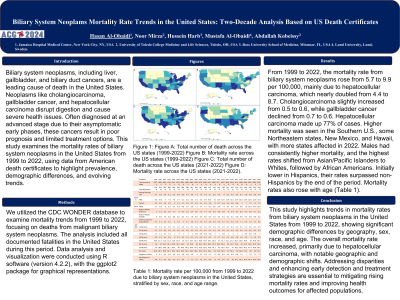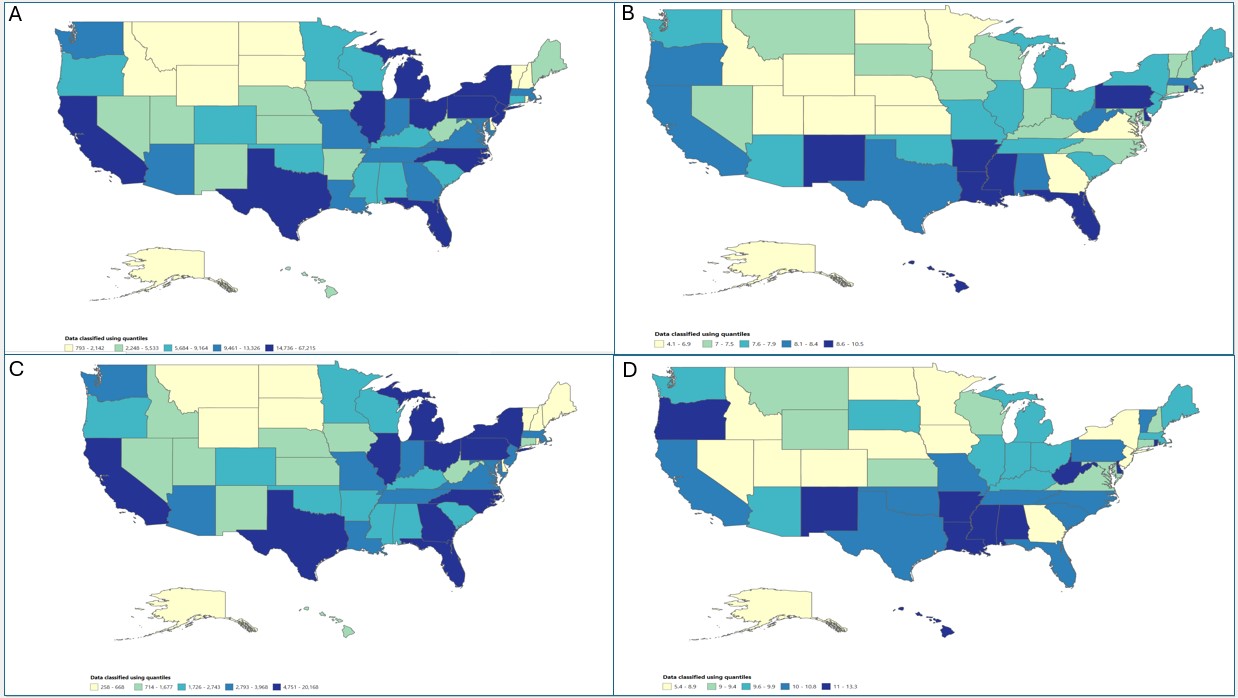Tuesday Poster Session
Category: Biliary/Pancreas
P3458 - Analyzing Mortality Rates for Biliary System Conditions in the United States: Insights From Death Certificates (1999-2022)
Tuesday, October 29, 2024
10:30 AM - 4:00 PM ET
Location: Exhibit Hall E

Has Audio

Hasan Al-Obaidi, MD
Jamaica Hospital Medical Center
Briarwood, NY
Presenting Author(s)
Hasan Al-Obaidi, MD1, Nooraldin Merza, MD2, Hussein Harb, 3, Mustafa Al-Obaidi, MD4, Abdallah Kobeissy, MD2
1Jamaica Hospital Medical Center, Briarwood, NY; 2University of Toledo College Medicine and Life Sciences, Toledo, OH; 3Ross University School of Medicine, Brooklyn, NY; 4Lund University, Malmö, Skane Lan, Sweden
Introduction: Biliary system neoplasms, including liver, gallbladder, and biliary duct cancers, are a leading cause of death in the United States. Neoplasms like cholangiocarcinoma, gallbladder cancer, and hepatocellular carcinoma disrupt digestion and cause severe health issues. Often diagnosed at an advanced stage due to their asymptomatic early phases, these cancers result in poor prognosis and limited treatment options. This study examines the mortality rates of biliary system neoplasms in the United States from 1999 to 2022, using data from American death certificates to highlight prevalence, demographic differences, and evolving trends.
Methods: We utilized the CDC WONDER database to examine mortality trends from 1999 to 2022, focusing on deaths from malignant biliary system neoplasms. The analysis included all documented fatalities in the United States during this period. Data analysis and visualization were conducted using R software (version 4.2.2), with the ggplot2 package for graphical representations.
Results: From 1999 to 2022, the mortality rate from biliary system neoplasms increased from 5.7 to 9.9 per 100,000, primarily driven by hepatocellular carcinoma, which nearly doubled from 4.4 to 8.7, cholangiocarcinoma up from 0.5 to 0.6, and gallbladder cancer down from 0.7 to 0.6. Hepatocellular carcinoma accounted for 77% of these cases. Higher mortality rates were observed in the Southern U.S., some Northeastern states, New Mexico, and Hawaii, with an increase in additional states from 2021 to 2022. Males consistently had higher mortality rates, with the gap widening over time. Initially, Asian or Pacific Islanders had the highest mortality rate, but by the end of the period, Whites had the highest rate, followed by African Americans, Asian or Pacific Islanders, and American Indians. Hispanics or Latinos initially had lower mortality rates than non-Hispanics, but this trend reversed by the end of the period. Mortality rates also increased with age (Table 1).
Discussion: This study highlights trends in mortality rates from biliary system neoplasms in the United States from 1999 to 2022, showing significant demographic differences by geography, sex, race, and age. The overall mortality rate increased, primarily due to hepatocellular carcinoma, with notable geographic and demographic shifts. Addressing disparities and enhancing early detection and treatment strategies are essential to mitigating rising mortality rates and improving health outcomes for affected populations.

Note: The table for this abstract can be viewed in the ePoster Gallery section of the ACG 2024 ePoster Site or in The American Journal of Gastroenterology's abstract supplement issue, both of which will be available starting October 27, 2024.
Disclosures:
Hasan Al-Obaidi, MD1, Nooraldin Merza, MD2, Hussein Harb, 3, Mustafa Al-Obaidi, MD4, Abdallah Kobeissy, MD2. P3458 - Analyzing Mortality Rates for Biliary System Conditions in the United States: Insights From Death Certificates (1999-2022), ACG 2024 Annual Scientific Meeting Abstracts. Philadelphia, PA: American College of Gastroenterology.
1Jamaica Hospital Medical Center, Briarwood, NY; 2University of Toledo College Medicine and Life Sciences, Toledo, OH; 3Ross University School of Medicine, Brooklyn, NY; 4Lund University, Malmö, Skane Lan, Sweden
Introduction: Biliary system neoplasms, including liver, gallbladder, and biliary duct cancers, are a leading cause of death in the United States. Neoplasms like cholangiocarcinoma, gallbladder cancer, and hepatocellular carcinoma disrupt digestion and cause severe health issues. Often diagnosed at an advanced stage due to their asymptomatic early phases, these cancers result in poor prognosis and limited treatment options. This study examines the mortality rates of biliary system neoplasms in the United States from 1999 to 2022, using data from American death certificates to highlight prevalence, demographic differences, and evolving trends.
Methods: We utilized the CDC WONDER database to examine mortality trends from 1999 to 2022, focusing on deaths from malignant biliary system neoplasms. The analysis included all documented fatalities in the United States during this period. Data analysis and visualization were conducted using R software (version 4.2.2), with the ggplot2 package for graphical representations.
Results: From 1999 to 2022, the mortality rate from biliary system neoplasms increased from 5.7 to 9.9 per 100,000, primarily driven by hepatocellular carcinoma, which nearly doubled from 4.4 to 8.7, cholangiocarcinoma up from 0.5 to 0.6, and gallbladder cancer down from 0.7 to 0.6. Hepatocellular carcinoma accounted for 77% of these cases. Higher mortality rates were observed in the Southern U.S., some Northeastern states, New Mexico, and Hawaii, with an increase in additional states from 2021 to 2022. Males consistently had higher mortality rates, with the gap widening over time. Initially, Asian or Pacific Islanders had the highest mortality rate, but by the end of the period, Whites had the highest rate, followed by African Americans, Asian or Pacific Islanders, and American Indians. Hispanics or Latinos initially had lower mortality rates than non-Hispanics, but this trend reversed by the end of the period. Mortality rates also increased with age (Table 1).
Discussion: This study highlights trends in mortality rates from biliary system neoplasms in the United States from 1999 to 2022, showing significant demographic differences by geography, sex, race, and age. The overall mortality rate increased, primarily due to hepatocellular carcinoma, with notable geographic and demographic shifts. Addressing disparities and enhancing early detection and treatment strategies are essential to mitigating rising mortality rates and improving health outcomes for affected populations.

Figure: Figure A: Total number of death across the US states (1999-2020)
Figure B: Mortality rate across the US states (1999-2020)
Figure C: Total number of death across the US states (2021-2022)
Figure D: Mortality rate across the US states (2021-2022)
Figure B: Mortality rate across the US states (1999-2020)
Figure C: Total number of death across the US states (2021-2022)
Figure D: Mortality rate across the US states (2021-2022)
Note: The table for this abstract can be viewed in the ePoster Gallery section of the ACG 2024 ePoster Site or in The American Journal of Gastroenterology's abstract supplement issue, both of which will be available starting October 27, 2024.
Disclosures:
Hasan Al-Obaidi indicated no relevant financial relationships.
Nooraldin Merza indicated no relevant financial relationships.
Hussein Harb indicated no relevant financial relationships.
Mustafa Al-Obaidi indicated no relevant financial relationships.
Abdallah Kobeissy indicated no relevant financial relationships.
Hasan Al-Obaidi, MD1, Nooraldin Merza, MD2, Hussein Harb, 3, Mustafa Al-Obaidi, MD4, Abdallah Kobeissy, MD2. P3458 - Analyzing Mortality Rates for Biliary System Conditions in the United States: Insights From Death Certificates (1999-2022), ACG 2024 Annual Scientific Meeting Abstracts. Philadelphia, PA: American College of Gastroenterology.
